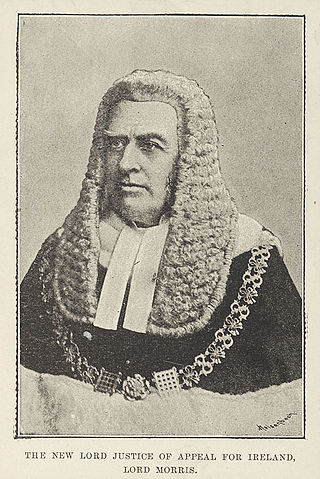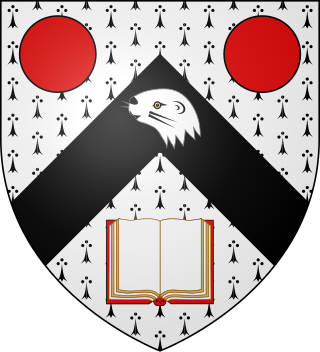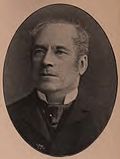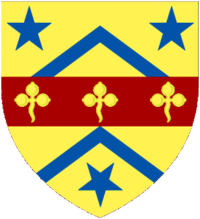Viscount Harberton, of Carbery in the County of Kildare is a title in the Peerage of Ireland. It was created on 5 July 1791 for Arthur Pomeroy, 1st Baron Harberton, who had previously represented County Kildare in the Irish House of Commons. He had already been created Baron Harberton, of Carbery in the County of Kildare, on 10 October 1783, also in the Peerage of Ireland. As of 2023 the titles are held by his descendant, the eleventh Viscount, who succeeded his uncle in 2004.
Baron Marchamley, of Hawkestone in the County of Salop, is a title in the Peerage of the United Kingdom. It was created in 1908 for the Liberal politician George Whiteley, who had previously represented Stockport and Pudsey in the House of Commons. As of 2014 the title is held by his great-grandson, the fourth Baron, who succeeded his father in 1994.

Viscount Devonport, of Wittington in the County of Buckingham, is a title in the Peerage of the United Kingdom. It was created on 22 June 1917 for the Liberal politician and former Member of Parliament for Devonport, Hudson Kearley, 1st Baron Devonport. He had already been created a Baronet, of Wittington in the Parish of Medmenham in the County of Buckingham on 22 July 1908, and Baron Devonport, of Wittington in the County of Buckingham, on 15 July 1910. As of 2017 the titles are held by his grandson, the third Viscount, who succeeded his father in 1973.

Baron Ashtown, of Moate in the County of Galway, is a title in the Peerage of Ireland. It was created in 1800 for Frederick Trench, with remainder to the heirs male of his father.

Baron Clanmorris, of Newbrook in the County of Mayo, is a title in the Peerage of Ireland. It was created on 6 August 1800 for John Bingham. He was a descendant of John Bingham of Foxford in County Mayo, whose brother Sir Henry Bingham, 1st Baronet, of Castlebar, was the ancestor of the Earls of Lucan. The first Baron's great-great-great-grandson, the seventh Baron, was a spy and crime novelist. As of 2010 the title is held by the latter's son, the eighth Baron, who succeeded in 1988.

Baron Fisher, of Kilverstone in the County of Norfolk, is a title in the Peerage of the United Kingdom. It was created in 1909 for the noted naval reformer Admiral of the Fleet Sir John Fisher.

Baron Hindlip, of Hindlip in the County of Worcester and of Alsop-en-le-Dale in the County of Derby, is a title in the Peerage of the United Kingdom. It was created in 1886 for the businessman and Conservative politician Sir Henry Allsopp, 1st Baronet. He was head of the brewing firm of Samuel Allsopp & Sons of Burton upon Trent, and he also represented East Worcestershire in Parliament.
Baron Gisborough, of Cleveland in the County of York, is a title in the Peerage of the United Kingdom. It was created in 1917 for the Conservative politician Richard Chaloner, who had previously represented Westbury and Abercromby in the House of Commons. Born Richard Long, the son of Richard Penruddocke Long, he had assumed by royal licence the surname of Chaloner in lieu of Long in 1881, as a condition of inheriting the Guisborough estate and Gisborough Hall from his maternal great-uncle, Admiral Thomas Chaloner. The latter was a descendant through his mother of Robert de Brus, who founded Gisborough Priory in 1119. Lord Gisborough's eldest son and heir, Richard Godolphin Hume Long Chaloner, was accidentally killed in France in 1917 while guarding German prisoners of war, and is buried at Calais. Lord Gisborough was therefore succeeded by his second son, the second Baron. As of 2011, the title is held by the latter's son, the third Baron, who succeeded in 1951. He notably served as Lord Lieutenant of Cleveland from 1981 to 1996. The title remains strongly linked with the town of Guisborough.
Baron Joicey, of Chester-le-Street in the County of Durham, is a title in the Peerage of the United Kingdom. It was created in 1906 for the coal mining magnate and former Liberal Member of Parliament for Chester-le-Street, Sir James Joicey, 1st Baronet. He had already been created a baronet, of Longhirst and of Ulgham, both in the County of Northumberland, in the Baronetage of the United Kingdom in 1893. He was succeeded by his eldest son, the second Baron. He was High Sheriff of County Durham in 1910. The second baron lost his son young, and on his death his younger brother succeeded to the barony. The third Baron was an army officer, whose elder son died in WWII without male issue, and he was thus succeeded by his younger son, the fourth baron. As of 2010 the titles are held by the latter's eldest son, the fifth Baron, who succeeded in 1993.
Baron de Freyne, of Coolavin in the County of Sligo, is a title in the Peerage of the United Kingdom. It was created in 1851 for Arthur French, 1st Baron de Freyne, with remainder to his younger brothers John, Charles and Fitzstephen French. He had earlier represented County Roscommon in the House of Commons and later served as Lord Lieutenant of County Roscommon. French had already been created Baron de Freyne, of Artagh in the County of Roscommon, in 1839, also in the Peerage of the United Kingdom but with normal remainder to heirs male. Lord de Freyne was childless and on his death in 1856 the barony of 1839 creation became extinct. The barony of 1851 creation survives according to the special remainder by his younger brother John, the second Baron.

Baron Killanin, of Galway in the County of Galway, is a title in the Peerage of the United Kingdom.

Baron Kinross, of Glasclune in the County of Haddington, is a title in the Peerage of the United Kingdom. It was created on 15 July 1902 for Scottish lawyer John Balfour, Liberal politician and Lord President of the Court of Session. His grandson, the third baron, was an author and journalist. As of 2019 the title is held by the latter's nephew, the fifth baron, who succeeded his father in 1985.

Baron Nunburnholme, of the City of Kingston-upon-Hull, is a title in the Peerage of the United Kingdom. It was created in 1906 for the former Liberal Member of Parliament for Hull and Hull West, Charles Wilson. His son, the second Baron, also represented Hull West in Parliament as a Liberal and served as Lord Lieutenant of the East Riding of Yorkshire between 1908 and 1924. The title descended from father to son until the death of the second Baron's grandson, the fourth Baron, in 1999. The late Baron was succeeded by his younger brother, the fifth Baron. As of 2014 the title is held by the latter's son, the sixth Baron, who succeeded in 2000.

Baron Burnham, of Hall Barn in the Parish of Beaconsfield in the County of Buckingham, is a title in the Peerage of the United Kingdom. It was created on 31 July 1903 for the influential newspaper magnate Sir Edward Levy-Lawson, 1st Baronet, owner of The Daily Telegraph. He had already been created a Baronet, of Hall Barn in The Parish of Beaconsfield in the County of Buckingham and of Peterborough Court in the City of London, in the Baronetage of the United Kingdom on 13 October 1892. Levy-Lawson was the son of Joseph Moses Levy, who acquired The Daily Telegraph only months after its founding.
Baron Congleton, of Congleton in the County Palatine of Chester, is a title in the Peerage of the United Kingdom. It was created in 1841 for the Whig politician, former Secretary at War, and Paymaster of the Forces Sir Henry Parnell, 4th Baronet. His eldest son, the second Baron, devoted his life to religious work and was an early member of the Plymouth Brethren. The latter was succeeded by his younger brother, the third Baron. He served in the Royal Navy and fought at the Battle of Navarino in 1827. His eldest surviving son, the fourth Baron, was a major general in the British Army and served in the Crimean War and the Anglo-Zulu War. The latter's eldest son, the fifth Baron, was killed in action in Ypres Salient during the First World War and was succeeded by his younger brother, the sixth Baron. As of 2015, the titles are held by the latter's grandson, the ninth Baron, who succeeded his father in 2015.
Baron Crawshaw, of Crawshaw in the County Palatine of Lancaster and of Whatton in the County of Leicester is a title in the Peerage of the United Kingdom. It was created on 25 August 1892 for Sir Thomas Brooks, 1st Baronet. He notably served as High Sheriff of Lancashire in 1884. Brooks had already been created a baronet in the Baronetage of the United Kingdom, of Crawshaw Hall and Whatton House, on 9 February 1891. As of 2013 the titles are held by his great-grandson, the fifth Baron, who succeeded his elder brother in 1997.

Baron Ritchie of Dundee, of Welders in the Parish of Chalfont St Giles in the County of Buckingham, is a title in the Peerage of the United Kingdom. It was created in 1905 for the Conservative politician Charles Ritchie. He was Home Secretary between 1900 and 1902 and Chancellor of the Exchequer between 1902 and 1903.
Baron Aldenham, of Aldenham in the county of Hertfordshire, is a title in the Peerage of the United Kingdom that was created on 31 January 1896 for the businessman Hucks Gibbs. He was head of the family firm of Antony Gibbs & Sons and a director and Governor of the Bank of England. Gibbs also briefly sat as a Conservative Member of Parliament for the City of London. His fourth son Herbert Cokayne Gibbs was created Baron Hunsdon of Hunsdon in 1923.

Fitzroy Hemphill, was a British baron and Liberal Party politician, the son of Charles Hare Hemphill, the first baron, and he succeeded his brother to the barony on 26 March 1918. Fitzroy was a barrister of the Middle Temple from 1899, served as a justice of the peace for County Galway. As well as politics he was a captain in 2nd battalion King's Own Scottish Borderers; a representative member of London's Territorial Force, Justice of the peace in Galway, Ireland; and 'Chevalier' of the Legion of Honour.

Earl of Arran is a title in the Peerage of Ireland. It is not to be confused with the title Earl of Arran in the Peerage of Scotland. The two titles refer to different places: the Aran Islands in Ireland, and the Isle of Arran in Scotland. The Irish earldom is held by the Gore family. The Scottish earldom is a separate title, held as a subsidiary title of the Duke of Hamilton.












